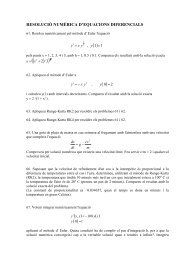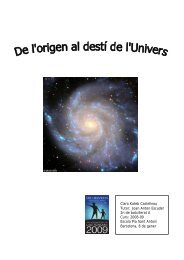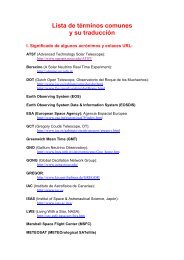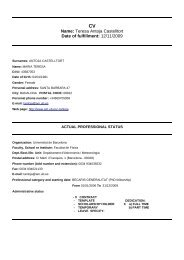Universitat de - Departament d'Astronomia i Meteorologia ...
Universitat de - Departament d'Astronomia i Meteorologia ...
Universitat de - Departament d'Astronomia i Meteorologia ...
You also want an ePaper? Increase the reach of your titles
YUMPU automatically turns print PDFs into web optimized ePapers that Google loves.
112 Chapter 3. LS 5039 as a runaway microquasar<br />
3.7 Conclusions<br />
After an in-<strong>de</strong>pth study of the proper motions and surroundings of LS 5039 our<br />
main conclusions are:<br />
1. Positions at optical and radio wavelengths have been used to compute in<strong>de</strong>-<br />
pen<strong>de</strong>nt optical and radio proper motions, which are perfectly compatible.<br />
Therefore, based only on astrometric data we are able to confirm that both,<br />
the optical and the radio emission, originate in the same object.<br />
2. From the combined optical and radio positions we have computed an accurate<br />
proper motion for LS 5039. This, together with the new estimate of 2.9 ±<br />
0.3 kpc for the distance (Sect. 2.5.3) and the radial velocity of the system<br />
(McSwain et al. 2001), allows us to compute a space velocity of (U = 51,<br />
V = −71, W = −118) km s −1 in its Regional Standard of Rest (RSR). This<br />
result implies that LS 5039 is a runaway microquasar with vsys 150 km s −1 ,<br />
escaping from its own RSR with a large velocity component perpendicular to<br />
the galactic plane. This is probably the result of the SN event that created<br />
the compact object in this binary system.<br />
3. We have computed the past trajectory of LS 5039. Two OB associations have<br />
been found close to its path in the plane of the sky. However, they are too close<br />
to us to be related to the microquasar. On the other hand, we have also found<br />
three SNRs near the path of LS 5039. After discarding two of them based on<br />
distance arguments, we have focused our attention on SNR G016.8−01.1. A<br />
study of this source could not clearly confirm nor reject the association due to<br />
the large uncertainties in the estimated radio flux <strong>de</strong>nsity of the SNR. This fact<br />
perhaps justifies future, high sensitivity searches of low-brightness remnants<br />
in this region.<br />
4. We have found a semi-open H i cavity close to the LS 5039 position. Although<br />
the O((f)) star in this microquasar seems to be the main agent forming the<br />
bubble, a contribution from the progenitor of the compact object cannot be<br />
ruled out.<br />
5. We have been able to explain both, the high space velocity and the high<br />
eccentricity observed, in a symmetric SN explosion scenario with a mass loss<br />
of ∆ M ∼ 17 M⊙.






